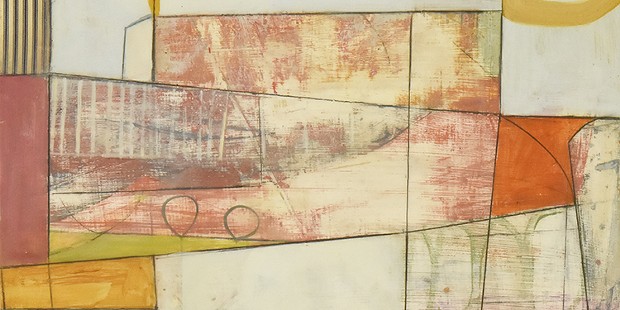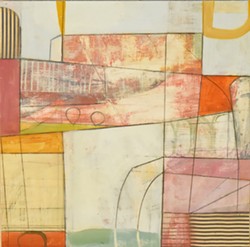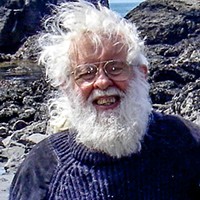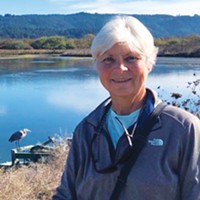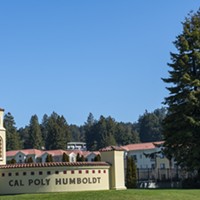Water Seekers and Pretty Ones
Abstract painting by Teresa Stanley and Kathleen Mahoney-Cobb
By Gabrielle Gopinath[
{
"name": "Top Stories Video Pair",
"insertPoint": "7",
"component": "17087298",
"parentWrapperClass": "fdn-ads-inline-content-block",
"requiredCountToDisplay": "1"
}
]
There was so so much going on my life, I had a desire to straighten everything up," Teresa Stanley said. Until recently, Stanley had been showing abstract paintings based on botanical imagery. The works in her new exhibition at Humboldt State University's Third Street Gallery leave those organic forms behind.
This new body of work features crisp networks of drawn lines that all look as if they had been incised with a protractor or a French curve. Lozenge-shaped grids are integrated within planes of luminous color. Compositions develop when linear elements cleave and fracture, creating flat patterns with a crisp clarity that recalls blueprints or electronics diagrams. Multiple compositions unfold outward from a central absence.
Stanley has taught painting and drawing to art students at Humboldt State University since 1991. Last year, mourning a death in the family and preparing to send her son off to college, Stanley was left contemplating "family, change and the fragility of life." She decided to start a new series of paintings based on her study of a family heirloom — an archive of working drawings made in pencil on vellum during the 1960s and '70s by her father Gordon, an engineer and pioneer in radio astronomy who died in 2001.
"Then, just as I started this project, the national election happened. And I was in the studio afterwards in a state of stunned disbelief, trying to understand the election results.
"'Water seeks its own level,' was the phrase that kept coming to mind," Stanley recalled. "It can be seen as a perorative, like, sinking to a certain level. But I was thinking about it in the opposite sense. I liked the image of an element that rises above."
Stanley began the series of paintings she came to call the Water Seekers by sketching structures that hold water like tanks, pipes and escarpments, consciously adopting aspects of her father's precision draughtsmanship. In the finished works, fields of luminous color are subdivided by networks of straight lines and regular curves that recall spigots and dowsing rods one moment, overhead views of circuitboards or cityscapes the next. In "The Water Seekers No. 2," shapes that look like hands or stems reach down from the painting's upper margin in search of a single precious, globular droplet.
Fabric shapes are set into the painted surface in most of these works. A textile with a motif featuring wavy white stripes on a nautical blue background becomes a symbol, as well as a recurrent element of collage.
Important things happen at the margins. In "Escarpment No. 2," a brilliant orange stripe placed against a pewter field on the perimeter pulls focus away from from the relatively open center of the composition. In "Protector," a fist-like shape balled in the upper lefthand quadrant emits rays that bisect the vaguely cell-shaped or mitochondrial structures floating across the way.
Stanley describes herself as "an abstract artist with narrative impulses." Figures hover in the offing of many of these works, moving now and then to assert a more substantial presence. In "Water Seeker No. 2," inchoate shapes that suggest plumbing or cartoonish body parts float in and out of recognizable existence. A pair of squat, paw-like hands wearing fingerless gloves reach down from above, extending what might be a dowsing rod.
Katherine Mahoney-Cobb's collection of abstract paintings all my pretty ones are also on display at Third Street this month. Here, too, figures verge on emergence. Big, fluidly applied brushstrokes in rosy flesh tones flash against dark backgrounds. Bodily shapes emerge from a jungle of shadows and folds, and then recede. Squeegee marks in peachy pinks recall the nude body's extensions. The nude in the academic painting tradition is not explicitly suggested but it is never far from mind.
Ed Moses' style is an influence but the heightened sense of the theatrical here has no parallel in that painter's work. Set in front of their dark backdrops, Mahoney-Cobb's sleek, bendy brushstrokes recall the dramatic contrasts of light and shade in Italian and Spanish baroque painting. The lavishness of the execution verges on ornament. Brushstrokes in buttery looking oil paint converge in the center of many of the compositions and a delicate oil residue has trickled down like hoarfrost from some of the marks' saturated margins.
Water Seekers and all my pretty ones will be on display from Oct. 3 through Nov. 5. Humboldt State University's Third Street Gallery (416 Third St., Eureka). A reception for the artists will be held at HSU Third Street Gallery Saturday, Oct. 7 at 6 p.m. during Arts Alive!
Speaking of...
more from the author
-
Nancy Tobin's CRy-Baby Installation at CR
- Feb 22, 2024
- More »
